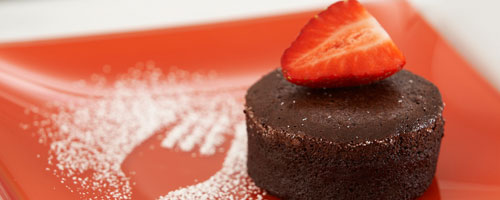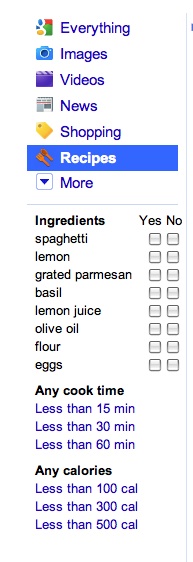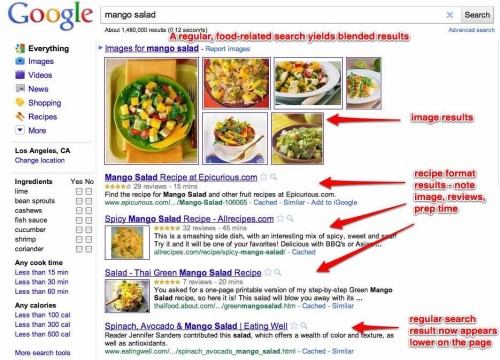
Google Recipe View
If you’ve Google-d for a recipe lately you may have noticed a new feature Google has launched, which is a recipe-specific search – they call it Recipe View. It allows the user to search results specifically designated as recipes, and also to narrow searches by ingredients, prep time and even calorie count. You access it via the “Recipes” option in the left menu bar on search pages.

What About Food Bloggers? Another Reason You’re Better Off With WordPress
It seems pretty useful for web searchers, but what does this mean for food bloggers? Well in order for your recipes to show up in this special search, Google is looking for you to use special markup i.e. code, to designate your content to be recipes. It’s called a microformat, which is a specific set of code tags used to designated content as recipes, with special parameters such as prep time, ingredients, reviews and more. Click here to see all the gory details
Integrating this formatting into your website and blog posts could actually be a serious drag depending on what blogging platform you use. Luckily, for self-hosted WordPress users, there is a plugin to help you with this. hRecipe gives you an easy to use interface in which to input your recipes with the correct markup. This should allow them to show up in Google recipe searches. On the downside it will probably make the process of entering your recipes a little more laborious. The plugin is easy to use, but requires a couple more small steps to creating your post. I’m sure more plugins will crop up as word of this development spreads. If you’re using another blogging platform, such as Google’s own Blogger, I’m not too sure how you would conveniently go about using the recipe microformat, without being willing to code (and let’s face it, people use Blogger because they don’t want to deal with code). You might be a little screwed, to be quite honest.
The more I look at it, the more I think this new development seems quite unfriendly to the food blogging community, as evidenced by the fact that currently you’ll see that the recipe results are being dominated by heavyweights like Foodnetwork, AllRecipes etc.
So the question is, will it be worth the effort for food bloggers to try and get on board? Since the pool of blogs using the markup is currently probably pretty small, if you jump on it, I would think you can leverage this change to your benefit and gain extra traffic.
Impact on Google Search Results Pages
One thing I did notice, which is another reason in favor of using the recipe microformat, is that if you do a regular Google search (ie. not using the Recipes submenu) for food-related things, especially if you include the word ‘recipe’, you’ll start to see ‘blended’ search result pages which include listings pulled from Recipe View. In a few searches that I tried, the results utilizing the recipe microformat seemed to be given priority. So this means that even if your blog post ranked highly for a particular recipe, that result could now be bumped down in the listings. See the screenshots below for a couple of examples I tried. You can tell if a result is using the Recipe Microformat because you’ll see additional info such as prep or cook time, reviews, and possibly a thumbnail image. Traditional web listings just show the title and description of the blog post. From this point of view it seems like it might be important to try and utilize this new markup. And if you are still using Blogger or another platform – this is yet another impetus to transition over to WordPress so you can utilize the plugin and take advantage of this development.
A regular Google search for ‘mango salad’: [click the images below to see the full size]

A regular Google search for ‘roast chicken’:

Are you planning on using the new recipe format? Seen any difference in traffic since this new development? Leave your thoughts and experiences in the comments.
*header image courtesy: ?http://www.flickr.com/photos/foodthinkers/4301030794/sizes/l/